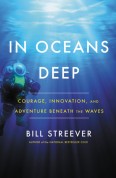In Oceans Deep: Courage, Innovation, and Adventure Beneath the Waves
By Bill Streever
Little, Brown and Company, 2019; 320 pages; $28.00
This book is about underwater life—of the human kind—written by a fine writer with genuine sea creden-tials. Though he cruises the ocean’s surface these days aboard a sailing yacht, Bill Streever spent countless hours below the surface in his earlier careers as a commercial diver and research biologist. Combining archi-val research, one-on-one interviews, and a bit of gonzo journalism, he examines various efforts, some fool-hardy and others heroic, to extend the range of human experience to the subsea world.
Among the more foolhardy, argu-ably, are the so-called “free divers” who descend and return to the surface on a single breath, with no artificial aid. Sponge divers in Greece and pearl divers in Japan have been doing this for centuries, but in mod-ern times free diving has morphed into a formal endurance sport. The current world record for a descent on a single breath, without fins, is 335 feet, held by William Trubridge, who runs a diving school in the Bahamas. Through practice, Streever has been able to free dive to 132 feet “without drama.” The difficulty is not in going down but in surfacing; free divers have been known to lose conscious-ness on the way up, often within a few feet of fresh air.
Coming up is also the trick for saner divers who use scuba gear or diving suits to stay submerged for more than the few minutes our puny lungs afford. Increasing pressure on the way down forces nitrogen, which makes up 80 percent of air, into the bloodstream and produces a “private narcotic haze,” known as nitrogen narcosis. What’s worse, high pressure oxygen, the other 20 percent of air, can cause convulsions and loss of consciousness. But watch out for worse problems on the return—too fast an ascent can cause nitrogen to bubble out of the blood, blocking arteries and veins and pressing on nerves—the painful, and potentially deadly affliction commonly called the “bends.” Slow decompres-sion, fortunately, allows nitrogen to diffuse more benignly, but that means the return to surface pressure after a descent of several hundred feet requires hours, or even days.
Limitations of human physiology can be avoided, of course, by encap-sulating terrestrial environments underwater—and Streever devotes a few dozen pages to a history of submarines, including military craft and research submersibles. He visits a factory that makes undersea craft for the very wealthy, equipped with leather seats, touch-screen controls, and surround sound, and he takes a ride to 1,300 feet on a private sub-marine in the Caribbean. For those on tighter budgets, Streever notes, there are now a variety of unmanned robotic vehicles equipped with cam-eras and grappling arms—the marine equivalent of drones.
Space is often called the “final frontier,” but Streever’s book makes clear that the deep, though much closer to us, is still tantalizingly distant. “Most life on earth is living in the dark under pressure,” said one of Streever’s interviewees, but that won’t include humans anytime soon. To date, only three people have been to the bottom of the deepest ocean trench, a mere seven vertical miles from the surface, while twelve people have walked on the Moon, a quarter of a million miles away.
